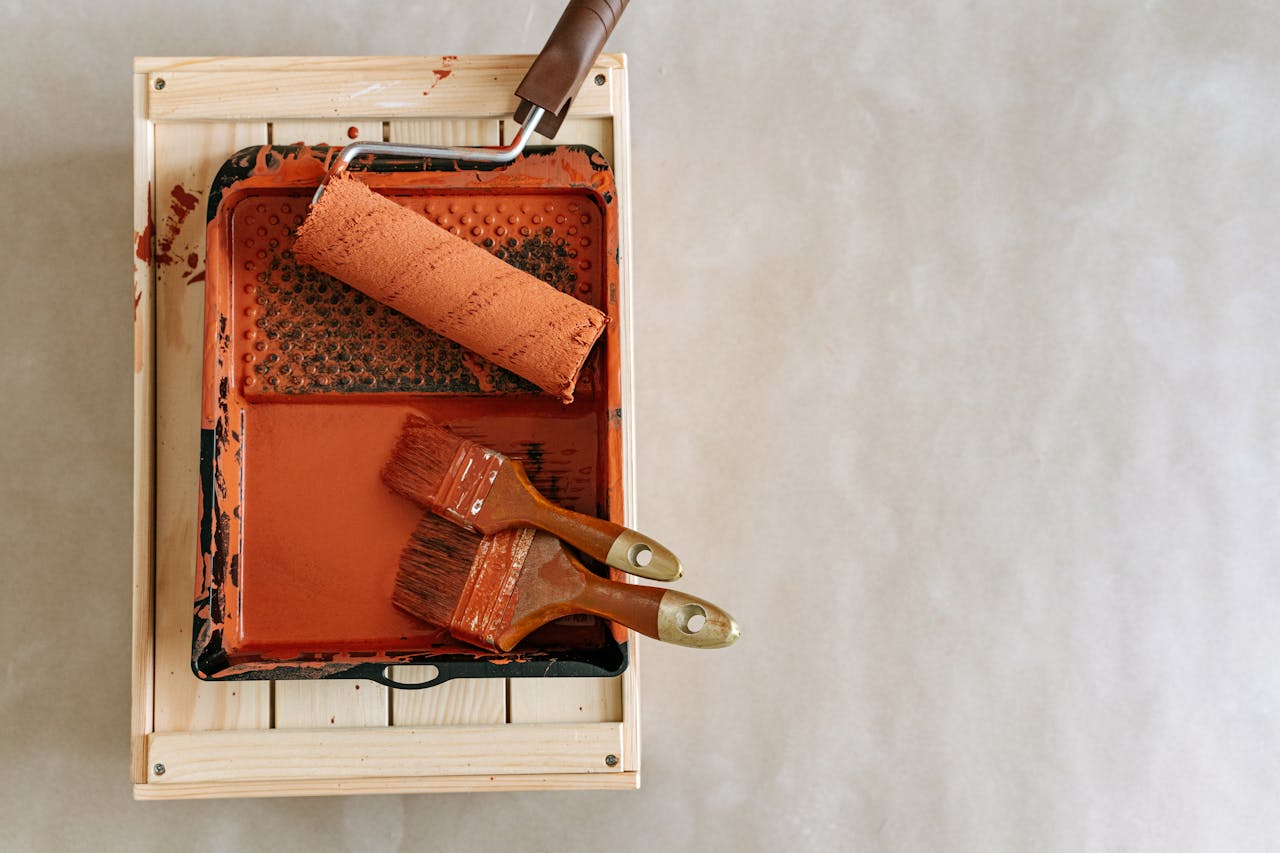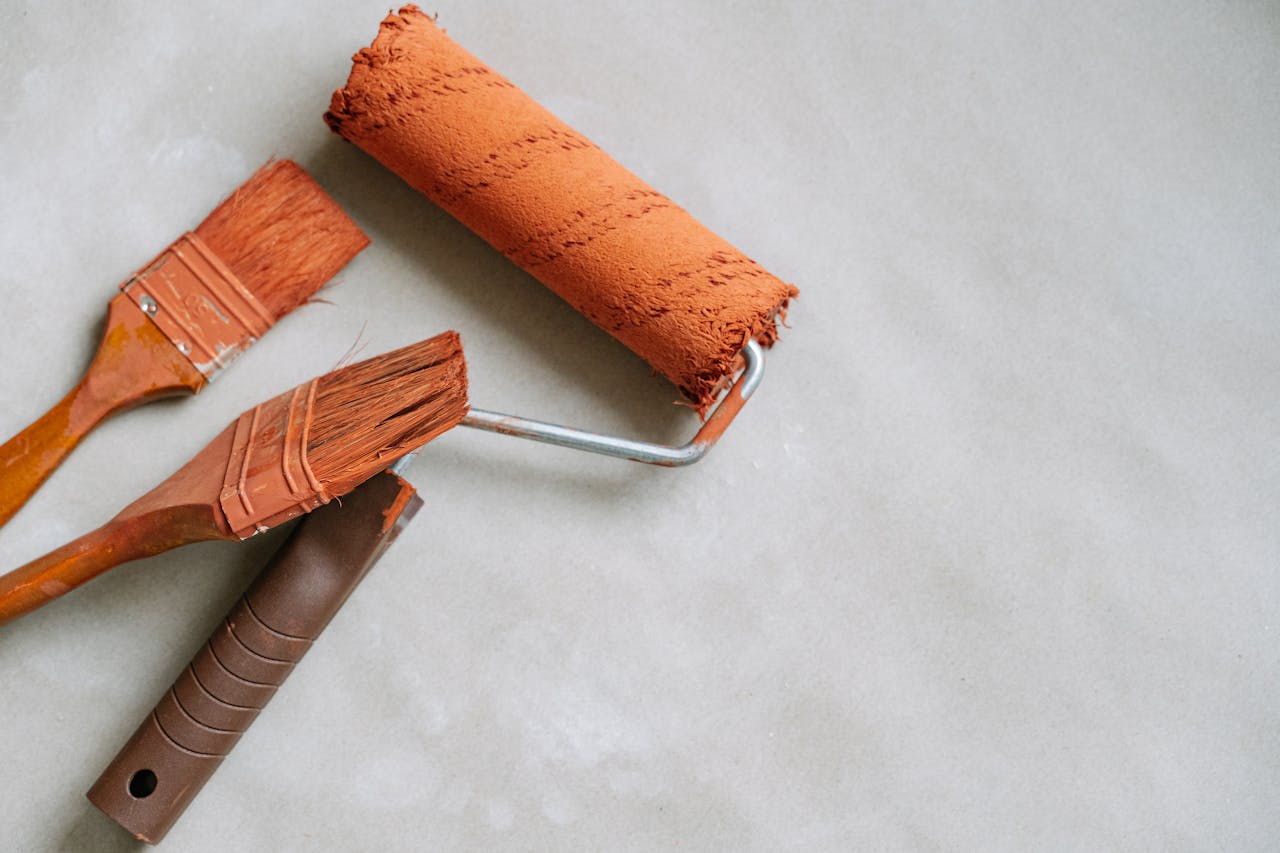Choosing the right tools for interior painting can make your project easier and more effective. With many options available, it can be challenging to know which tools to use. If you need help with buying tools, we will guide you through selecting the best ones for your interior painting needs.
What are the Most Common Tools Used for Interior Painting?
Choosing the right tools for interior painting can make your project easier while also getting the best results. Here are some of the most common tools used:
Paint Brushes
Paint brushes are essential for interior painting. They are ideal for detailed work and cutting in around edges and corners. Brushes come in various sizes and shapes suited for different tasks. A good quality brush can provide better coverage and a cleaner finish.
Using a brush allows you to reach areas that rollers cannot. It is important to choose the right type of bristle for the paint you are using. Synthetic bristles work best with water-based paints, while natural bristles are better for oil-based paints.
Paint Rollers
Paint rollers are great for quickly covering large areas. They are available in different sizes and nap lengths to suit various surfaces. Rollers can apply paint evenly and create a consistent texture on walls and ceilings.
Choosing the right roller cover is crucial for achieving the desired finish. Short nap rollers are best for smooth surfaces while long nap rollers are suitable for rough or textured surfaces. A quality roller frame and cover can make the job easier and more efficient.
Painter’s Tape
Painter’s tape is used to mask off areas that you do not want to paint. It helps create clean, sharp lines and prevents paint from bleeding onto other surfaces. This tape is available in various widths and adhesive strengths.
Applying painter’s tape correctly can make a big difference in the final outcome of your project. Make sure to press the tape down firmly to avoid paint seeping underneath. Remove the tape carefully after the paint has dried to avoid damaging the painted surface.
Drop Cloths
Drop cloths protect floors and furniture from paint splatters and spills. They are available in different materials, including canvas, plastic, and paper. Using drop cloths can save you time and effort when cleaning up after the job is done.
Choose a drop cloth that is appropriate for the area you are working on. Canvas drop cloths are durable and reusable, while plastic ones are lightweight and disposable. Make sure to cover all surfaces thoroughly to prevent any accidental paint damage.
Paint Trays and Liners
Paint trays and liners are essential for holding and distributing paint. They allow you to load your roller or brush evenly without making a mess. Using a liner in your paint tray can make cleanup easier and prolong the life of the tray.
Choose a paint tray that is sturdy and the right size for your roller. Liners are available in different materials such as plastic and disposable paper. They fit inside the tray and can be removed and discarded after use making cleanup quick and simple.
How to Choose the Best Tools for Interior Painting
With so many different tools to choose from, it can be difficult for one to find the best ones among the rest. However, by knowing specifically what to look for, you will have a much easier time buying the best tools for the job. Below are some tips that you can follow to pick the best tools for interior painting.
Consider the Surface
Different surfaces require different tools. Smooth walls may need short nap rollers, while textured surfaces might need long nap rollers. Choose brushes with the appropriate bristles for the type of paint you are using.
Quality Over Price
Investing in high-quality tools can save you time and effort. Better tools often provide better coverage and a cleaner finish. They are also more durable and can be reused for future projects.
Size and Shape
Choose the size and shape of tools based on the area you are painting. Smaller brushes are good for detailed work and trim, while larger rollers are better for covering large areas quickly. Make sure the tools fit comfortably in your hand.
Compatibility with Paint
Make sure your tools are compatible with the type of paint you are using. Synthetic bristles are best for water-based paints, while natural bristles work well with oil-based paints. Check the roller cover’s nap length to match the paint and surface.
Ease of Cleaning
Consider how easy the tools are to clean, especially if you plan to reuse them. Brushes and rollers that are easy to clean will last longer and provide better results. Look for tools with removable parts or disposable liners for convenience.
Read Reviews
Before purchasing tools, read reviews from other users. This can give you insight into the performance and durability of the tools. Look for feedback on ease of use and the quality of the finish they provide.
Hiring Painters for Interior Painting Projects
There will be many situations during the project that can be difficult to handle on your own. So, the best way for you to deal with these situations is to simply hire the best professionals for the projects. Below are the reasons to consider hiring professionals:
- Expertise and Experience: Professional painters have the skills and knowledge to deliver high-quality results. They know the best techniques and materials to use for different surfaces.
- Time-Saving: Painting can be time-consuming, especially for large areas or detailed work. Hiring professionals allows you to focus on other tasks while they handle the painting efficiently.
- Proper Preparation: Professional painters take care of all the necessary preparation work. This includes sanding filling holes and priming surfaces to ensure a long-lasting finish.
- Quality Finish: Professionals can achieve a better finish with no streaks or uneven areas. Their attention to detail and experience with different paints and tools result in a polished look.
- Safety: Painting can involve working at heights or with hazardous materials. Professional painters have the proper equipment and training to handle these safely.
- Clean-Up: After completing the job, professional painters clean up the area. This means you won’t have to worry about disposing of paint cans or cleaning brushes and rollers.
- Cost-Effective: While hiring painters may seem expensive, it can actually save money in the long run. Professional work can last longer and reduce the need for touch-ups or repaints.
Conclusion
Whether you are painting a large wall or intricate trim using the proper tools will improve your results. Investing in good quality brushes rollers and other equipment will save you time and effort in the long run.
For professional help with your interior painting projects, contact Custom Painting Inc. Call us at 925-294-8062 or fill out a Contact Form to learn more about our services.



